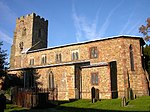Stanford Park
Sites of Special Scientific Interest in Leicestershire

Stanford Park is a 20.4 hectares (50 acres) biological Site of Special Scientific Interest east of Swinford in Leicestershire.The park has avenues of oak trees, together with other large trees in an area of pasture. It has the most diverse lichens in the county on the bark of mature trees and on old stonework, including fifteen species not recorded elsewhere in Leicestershire.The park is the grounds of Stanford Hall, a stately home which is open to the public.
Excerpt from the Wikipedia article Stanford Park (License: CC BY-SA 3.0, Authors, Images).Stanford Park
Stanford Road, Harborough Westrill and Starmore
Geographical coordinates (GPS) Address Nearby Places Show on map
Geographical coordinates (GPS)
| Latitude | Longitude |
|---|---|
| N 52.406 ° | E -1.14 ° |
Address
Stanford Road
Stanford Road
NN6 6JR Harborough, Westrill and Starmore
England, United Kingdom
Open on Google Maps








